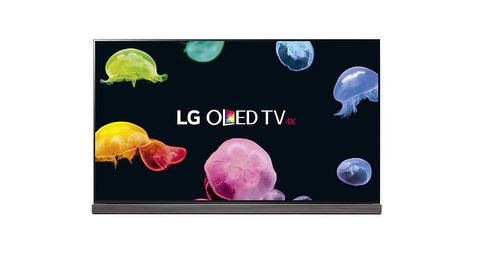TechRadar Verdict
To see the OLED65G6 is to fall in love with it. This is clearly one of the best TVs of 2016 as it's both beautifully designed and produces some of the best pictures we've ever seen. All that said, it's a bit too pricey – especially considering that you can buy the almost equally as nice OLED E6 for £1,500 less.
Pros
- +
Ridiculously gorgeous design
- +
Beautiful contrast-rich pictures
- +
Strong audio performance
- +
Great smart TV interface.
Cons
- -
It's very expensive
- -
Brightness limited for HDR
- -
Clipping in brightest areas
- -
Sometimes clumsy motion handling.
Why you can trust TechRadar
If you're a serious AV fan you'll already know all about LG's OLED TVs. For many picture quality enthusiasts, the way OLED technology enables every pixel in a 4K/UHD TV to deliver its own light and colour independent of its neighbours gives it an unassailable advantage - especially where contrast is concerned - over rival LCD screens.
With LG's OLED65G6, though, OLED's innate technological advantages are just the start of its high-end charms. This flagship 65-inch TV - part of LG's so-called 'Signature' range of ultra-premium products - also enjoys a truly gorgeous design, as well as a sound system that's more powerful and impressive than the one built into LG's step-down E6 OLED TVs.
With so much quality on show throughout LG's OLED range this year, though, the one question the OLED65G6 may struggle to answer is whether it offers enough unique advantages to justify buying it instead of one of its brethren - especially considering its eye-watering £5999 price.
Design
One word comes to mind here: Wow. It's tempting to just write that and move on. But one word doesn't do LG's immaculately designed flagship justice. Particularly mind-boggling is the screen's incredible slimness, which finds the entire panel - all 65 inches of it - coming in at less than 3mm deep.
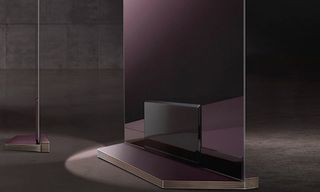
This incredible design feat is possible for three reasons. First, since OLED pixels produce their own light there's no need for an external light source. Second, LG has managed to mount the paper-thin OLED film directly onto a sheet of hardened glass. Finally, unlike the cheaper E6 OLED series - which also benefits from the so called 'Picture on Glass' technique - the G6 puts all of its electronics and drivers into its desktop stand rather than sticking them into a bulgy bit on the TV's rear.
The OLED65G6's stand doesn't just differ from most because it has the TV's 'brains' - and connections - in it, either. It also sports a 60W, 4.2-channel speaker bar on its front edge that delivers way more audio power than such an incredibly skinny TV would be able to otherwise, and it can even pivot around and back to become a wall mount.
As if all this wasn't already clever and glamorous enough, the sound bar features speakers on two of its edges, so that you get forward-firing sound regardless of whether you're using the base as a table-top stand or wall mount.
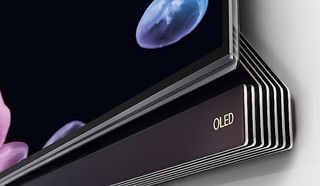
There are of course a few contrarians out there who may wish to detach the soundbar, I guess, to make the OLED65G6's design even cleaner and more minimalistic. And while the option would be nice to have, don't forget that you'd still need some sort of external bodywork to both support the screen and hold the driver electronics and connections.
These connections - which include four HDMIs, three USBs, and the now obligatory wired and Wi-Fi network options - are fiddly to access on the thin mounting plate/stand. But this seems a small price to pay for the OLED65G6's aesthetic glories.
Screen sizes available: 65-inch, 77-inch | Tuner: Freeview HD, Freesat HD | 4K: Yes | HDR: Yes | Panel technology: OLED | Smart TV: Yes, webOS 3.0 | Curved: No | Dimensions: 1625 x 66 x 883mm (W x D x H) | 3D: Yes | Inputs: four HDMIs, three USBs, Wi-Fi, Ethernet, tuner inputs, headphone jack, optical audio output
Design TL;DR: If there's a more immaculately designed TV than the LG OLED65G6, I haven't seen it.
Smart TV: WebOS 3.0
LG's webOS smart TV became an instant classic when it first launched in 2014. Since then LG hasn't in truth changed it much - but it really hasn't needed to, as its brilliantly economical layout, superbly intuitive structure, easy customisation and lickety-split response times mean it's still the system to beat for sheer ease of use.
The amount of content links it's able to deliver on screen at once without feeling cluttered or hiding the TV picture sets a great tone right away, while the use of high quality visuals and lots of graphical cues to ensure you're never in doubt where you are in the menus means that even the most technophobic users always feel 'in charge'.
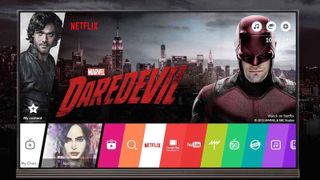
The only real issue I have with the OLED65G6's smart system is that mystifyingly it doesn't include the Freeview Play 'app' found on all of LG's other, cheaper 2016 OLED TVs. This means you don't get the All4 and ITV Hub catch up TV platforms, and nor can you explore missed content via Freeview Play's back-scrolling electronic programme guide.
LG's official explanation for the G6 not having Freeview Play is that the sort of high-end consumers this TV is aimed at will likely have external sources for satisfying their catch up TV needs. But I'm not sure I'm totally convinced by this.
Smart TV TL;DR: WebOS is as slick, empowering and friendly as ever, though the lack of Freeview Play support on this flagship OLED TV is weird to say the least.
HD/SDR performance
Differences between the OLED65G6's picture performance and that of its 2016 OLED siblings are fairly minimal. This is arguably rather good news when you think that those siblings have already been responsible for the most gorgeous standard dynamic range pictures the TV world has seen to date.
Providing the foundation for the OLED65G6's SDR heroics are the sort of class-leading black level depths that only OLED's 'self-emissive' technology can deliver. So long as you keep the TV's brightness setting below its 53 level (at 53 and more the black levels suddenly plummet) parts of the picture that should look black basically look exactly that: black.
Even better, the beautiful rich black colours remain completely unblemished by LCD-related problems such as backlight clouding and bleeding. This immediately makes the OLED65G6's dark scenes look more consistent and immersive, as you don't have to be distracted by regular reminders of the technology the TV is using to produce its pictures.

The spectacularly profound blacks also provide a stunning point of contrast for the OLED65G6's SDR colours, making them look markedly more vibrant and rich - even during dark scenes - than they do on the vast majority of rival TVs.
Being able to deliver light differentials right down to pixel level also gives colours a tonal subtlety that's again rarely matched, helping pictures look both ultra-detailed and more full of depth.
Thanks to the extra brightness LG has managed to deliver with its OLED TVs this year, meanwhile, the OLED65G6 gives you a beautiful sense of balance in shots that contain a dramatic mixture of light and dark content, avoiding both the common (with LCD TVs) situation where dark areas look devoid of detail or over-dominant, and the old OLED issue whereby bright areas can look muted or 'cramped' versus LCD screens.
Add to all these strengths a touch more refinement and warmth in the OLED65G6's SDR pictures than you get with LG's step down E6 OLED series, and it's fair to say that for much of the time watching the OLED65G6 will have serious AV fans feeling like they've died and gone to AV heaven.
The OLED65G6's most emphatic SDR picture results come when you feed it a native UHD source, for while it's certainly not a bad upscaler of HD sources its upscaled results aren't quite as crisp as the best of its rivals.
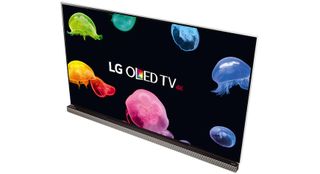
The only real issue I have with the OLED65G6's SDR pictures, though, is that motion isn't especially well handled, suffering either with more judder than I'd ideally see without the motion processing in use, or some unwanted glitches if you do use the motion processing.
It's worth wrapping this section up by saying that the OLED65G6 is an outstanding player of 3D Blu-rays if you have any. So much so that if 3D had always looked so good, I'm pretty sure 3D for the home wouldn't be in its current malaise.
HD/SDR performance TL;DR: Astonishing contrast and blistering but also subtle colours make the OLED65G6 nothing short of amazing with SDR content.
4K/HDR Performance
At first glance the OLED65G6's 4K HDR performance with Ultra HD Blu-rays looks even more brilliant than its SDR pictures.
For instance, there's a genuine sense of the expanded luminance range that's HDR's big attraction, with more dramatic brightness peaks sitting right alongside those still beautifully inky blacks. There's also markedly more intensity in the image's colours versus the old Blu-ray versions of the same films.
Finally, Ultra HD Blu-ray pictures enjoy that general sense of feeling more lifelike and 'real' that the combination of HDR and 4K resolution makes possible.
Particularly extreme HDR content, though, does uncover a couple of issues with the OLED65G6's HDR performance. First and worst, even though this screen can deliver something approaching 700 nits of brightness (a substantial rise on 2015's OLEDs), the brightest parts of HDR images can suffer with some very noticeable 'clipping' - a phenomenon whereby fine details and subtle colour tones aren't rendered properly. This leaves such areas looking bleached out and monotone.
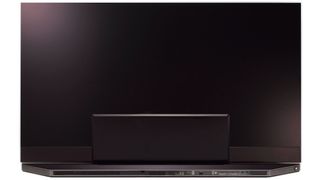
The other issue is that when shots contain a fairly extreme combination of bright and dark content, the dark parts of the picture feel a touch dominant - partly because they look a bit short of the sort of shadow detail that's expressed so well when watching SDR. Basically you just can't help but feel with such high-contrast shots as if the whole picture needs a slight brightness 'lift'.
At this point I need to make it clear that I'm talking about the OLED65G6's playback of so-called 'HDR10' content - the industry standard HDR format supported by every HDR TV. All of LG's OLED TVs this year, though, can also support the Dolby Vision HDR format - and the OLED65G6's performance with this is both remarkably different and, for the most part, considerably better.
The biggest improvement is the resolution of much more detail and colour tone information in the brightest picture areas. But colours, too, look both richer and more subtly toned and blended.
The trade off for these considerable Dolby Vision advantages is that the format lowers the overall brightness of its HDR presentation. But for me the advantages comfortably outweigh the downside - which makes it a real shame there are currently so few real-world Dolby Vision sources available to watch. In fact, in the UK at the time of writing Dolby Vision provision is limited to just a handful of shows on Netflix.
When it comes to 'selling' the advantages of its native 4K resolution, the OLED65G6's large screen and exquisite, pixel-level light control do a mostly good job of backing up the sheer volume and density of the pixels. The only catch is that the intense (though not quite class-leading) sharpness of native 4K playback can slightly highlight the TV's clipping in bright HDR areas and occasional absent shadow detailing in dark HDR areas.
4K/HDR performance TL;DR: Although the extreme brightness demands of HDR cause even a screen as mighty as the OLED65G6 a few problems, overall its HDR 4K images are still more often than not seriously lovely.
Sound
Curiously and, as it turned out eventually, unfairly, my first impression of the OLED65G6's audio wasn't entirely positive, as I felt it just didn't carry the same raw power and dynamism that I'd experienced on the cheaper E6 OLED series.
More prolonged listening to a variety of action movie sources, though, shows that while it might not sound quite as aggressive as the E6, the OLED65G6 actually delivers quite a bit more refinement, detail and control - features which add up to an overall more immersive sound performance.
What you'll find here is a refined speaker arrangement that even works very nicely as a hi-fi system for playing music – something I may not have ever said before about a TV's built-in sound system.
Sound quality TL;DR: The OLED65G6 is, for my money, the best sounding TV 2016 has delivered so far.
Other panels to ponder
We're in a pretty rarified part of the TV market with the OLED65G6, so direct competition at the same price is limited. The most tempting alternative for £6,000 would be Sony's 75-inch KDL-75XD9405. As well as giving you 10 inches more picture, this TV delivers slightly more peak brightness for better, more detailed HDR brightness peaks. However, it suffers backlight clouding problems with dark HDR scenes that the OLED65G6 does not, and isn't as bright as some LCD rivals.
For other alternatives we need to turn our sights lower down the pricing ladder. Samsung's UE65KS9500 at £3,800 provides literally twice as much peak brightness as the OLED65G6, meaning it reaches the bright HDR parts the LG OLED simply cannot reach. This, together with a direct backlighting system and local dimming engine, helps to deliver simply the most dramatic HDR pictures currently available. However, as with the Sony 75XD9405, the UE65KS9500 can sometimes suffer distracting backlight clouding during dark HDR scenes, and there's occasional colour striping during Ultra HD Blu-ray playback.
Perhaps the single most convincing alternative to the OLED65G6 is LG's own OLED65E6. This set lacks a little - though only a little - of the audio and picture refinement of the OLED65G6, and its design isn't quite as incredible. But for me it gets close enough to the OLED65G6 to make its £4,499 price look like a relative steal - and the OLED65G6's £6,000 price look a bit hard to justify.
Verdict
To see the OLED65G6 is to fall in love with it. Its jaw-dropping sub-3mm design is like nothing the the TV world has ever given us before, and will have anyone who sees it turning green with envy.
Its webOS operating system is a joy to use too, while its OLED technology helps it produce picture quality that at times is the best in the business. Its innovative sound bar even means it sounds excellent despite its ground-breakingly slim chassis.
While it excels with SDR and the dark half of HDR video, though, it struggles a little to rise to the challenge of HDR's brightness extremes. Also, unless you're lucky enough to belong to the "money's no object" club, it'll be hard to ignore the £1,500 cheaper LG OLED65E6.
AV Technology Contributor
John has been writing about home entertainment technology for more than two decades - an especially impressive feat considering he still claims to only be 35 years old (yeah, right). In that time he’s reviewed hundreds if not thousands of TVs, projectors and speakers, and spent frankly far too long sitting by himself in a dark room.
